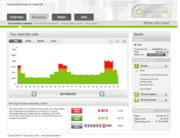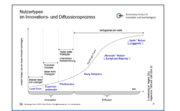The User in the Energy System - Interfering Factor or Actor?
| ► | Back to the Lecture Series: Energy in Development |
Presentation (in German)
Environmental Psychology (not only) for Engineers
For the typical engineer, human beings appear as a disruptive factor which is hard to calculate. But the tragedy is that efficiency measures only work if the user is implemented. That is why the profession of environmental psychology came into being. In the context of the lecture series "Energy in Development" it refers to the human being in the energy system, especially in the field of Man-Technics-Interaction (MTI). To get a clearer idea of this topic Prof Matthies explained the origins of this profession.
Defining Psychology: Most people think psychology would only look at behaviour that deviates from the norm. Actually, psychology is more generally defined as science of experience and behaviour. Cognition is the most general part of psychology.
Defining Environment: To give an idea of how psychologists define "environment" Prof. Matthies gives some examples.
Architecture can be designed to support communication and prevent vandalism.
She also asks us to look around and to become aware of the lecture room. It can tell us something about the social situation that we are in. The room enhances one-directional lecture. It stands for an educational tradition. Even if we try to create a new way of learning by organizing this lecture series, the social environmental has an inflict on our discourse.
Nowadays, psychologists usually conduct priming experiments in laboratories, but environmental psychologists want to study humans in their environment.
Technical innovations are always social innovations too. Environmental psychology can help to enhance the diffusion of technical innovations by motivating in a social way.
Users as Interfering Factor in the Energy System
Users in the developed world don't plan to consume electricity. In 2013 a survey found out that 80% of the Germans want to save energy. Reasons were to save money, to reduce to CO2 reduction/ pushing the transition of the energy sector, to avoid wasting resources and to not give money to the big utilities. However, these motivation have nothing to do with the reasons why we do use electricity. If you want to go out and your favourite clothes are still wet, you dry them - normally you are not aware of consuming energy.
Users as Actors
Intervention strategies
Users considered as actors in a topic like energy saving can be at different stages of conviction.
To help pushing users forward intervention strategies can be used. Before measures to convince users can be taken it is important to understand, at what stage on the way to an altered behaviour the user is.
According to Bamberg there are four steps (percentage referring to energy saving in households):
- Precontemplation (18,8 %): At this stage people only begin to reflect on the issue.
- Contemplation (38,4 %): Most of the people have already stated that they want to save energy but they don't know how to start.
- Preparation/Test (13,6 %): Only few people are in the state of preparing to start saving energy.
- Maintenance (29,2 %): Luckily, already a remarkable number of users in the conducted study are working on maintaining their energy saving strategies.
To go from step 1 to step 2 a goal intention has to be formulated ("I want to save energy"). To get from step 2 to step 3 a behavioural intention has to be formulated ("I want to defrost the freezer"). An implementation intention leads from step 3 to step 4 ("Tomorrow morning I want to defrost the freezer"). Finally, a new custom has to exist: "I am going to defrost the freezer monthly".
Being Supported by Technology
Technology is invented to assist users.This example shows how technology does NOT support users. On the picture on the right side you can see... What can you see? The designers of the smart meter giving this graph, meant it to show what amount of energy was used at what time. But what the user actually wants to know is: How can I save energy? The graph on the right side shows some peak loads that are coloured in red but it does not recommend to buy a new refrigerator or to turn off the plugs connected with the charging cable. To help users that already convinced to save energy one would need device specific information.
In a developing country this system wouldn't work out. This meter costs - including sponsoring - 150€. That amount of money cannot be saved! The motivation for poor people equals zero for a system like this.
Helping to Design and Spreading the Word
Conclusion
The multidisciplinary research group "MicroEnergy-Systems" is looking into strategies and instruments to conceptualize, produce and implement sustainable microenergy systems in off-grid regions in developed and developing countries.
Environmental psychologists can help to conceptualize and to implement new technologies.
- Users can be understood in their respective context: social impacts, culture
- Users can be integrated to conceptualize and to spread the word.
What can the developed world learn from the developing countries in terms of energy saving? Tanzanian families don't need smart meters. They spend 20 to 30% of their income for their energy supply. They have to pay the power meter, the system maintenance and so on. Another difference is that the utilities send employees to go and collect the money of the electricity users. This is one part that describes the very different presence.
To motivate people to save the environment, fairness is of importance. Climate change is a global threat related to huge amounts of money. It is irrationally not wanting to contribute to a sustainable climate. But when people think others - who did not contribute - could profit from their actions, then motivation fails.
From Prof. Matthies' point of view everyone should try and set a good example when a global public good like the climate is in danger and not loose their motivation if others back down.
Open fires in closed spaces is a daily health burden for women and infants but this is a common situation in many developing countries. That is why a lot of information has to be provided. Successful innovations use social networks and/or let target users try out first. Advantages should be directly remarkable, communicable and visible.
The 'Energy-trans' study that Prof. Matthies conducted, found out that to get from motivation to changing of habits, smart meter portals should get smarter. The software should be capable of take individual needs into account.
Engineers or other system designers have to be bewusst about to design products that are accepted by future consumers. Most important is to acknowledge that human beings have a strong will not to have inflicts into their decision making. Irrationally they can try to outwit the implemented system to feel responsible about their own lives.
Recent designs propose flashing symbols (in an office space not publicly visible) or colours as feedback if e.g. a window is opened while the radiator is heating. These warnings are less invasive and let the user choose to act according to the proposed scheme.
Social norms for altruistic behaviour are underestimated.






















